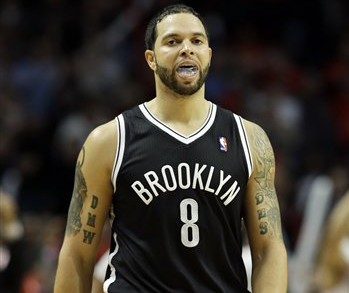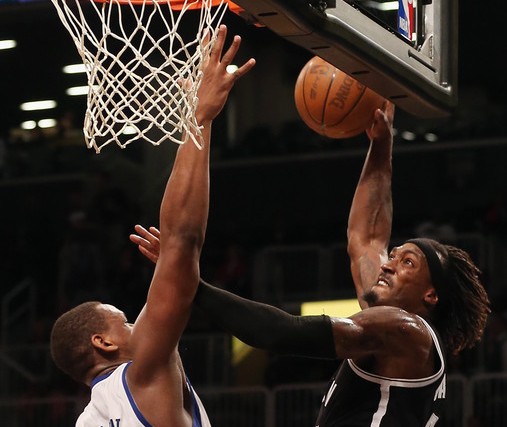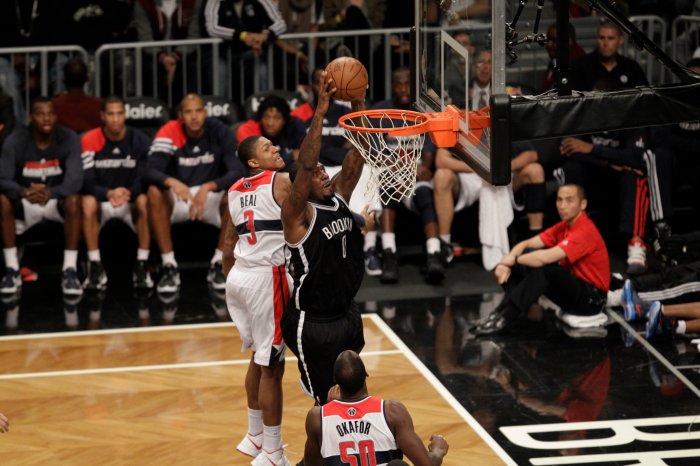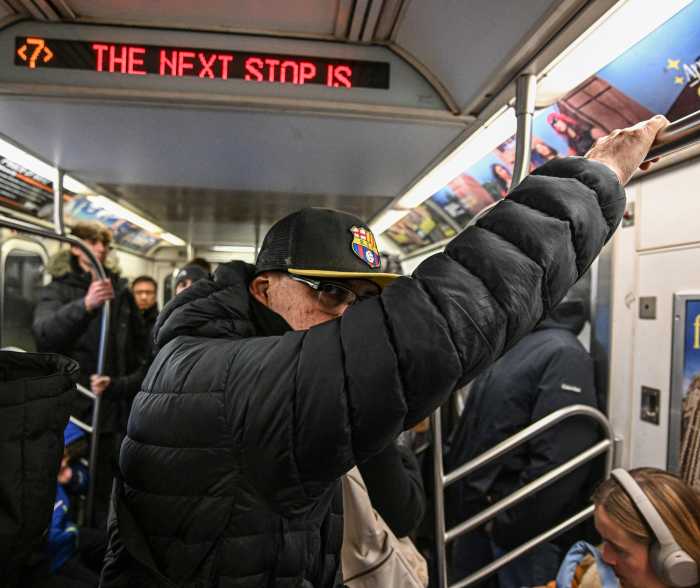Your team’s down three. 10 seconds left to play. You grab the rebound and streak down the center of the court. Derrick Rose … er, scratch that. Rajon Rondo is guarding you tightly — there’s no way you’ll ever get a shot up. You see two open teammates. You have to hit one of them from the dagger three. You turn to the left: there’s Vince Carter, wide open on the wing. You turn to your right: there’s George Costanza, who’s even more open — only his hands are occupied by an eclair that you’re fairly confident he snatched from the garbage can in the locker room.
What do you do?
You chuck the ball out of bounds, you tell your head coach, “I’d rather leave here tonight with my dignity than pass to one of those losers,” and you head to back to the showers.
See, even though they’re divided by the ever-diminishing barrier of reality, Carter and Costanza have more in common than one might think, and those similarities are centered around coming up short — whether taken literally, figuratively or both. The “Lord of the Idiots” and the Lord of … (I didn’t care enough to finish coming up with a representative name for myself)” have both had their fair shares of losing during their careers, and those will be the main focus here.
Just how comparable are the career paths of Vinsanity and Art Vandelay? What do you say we go through this doll by doll?
The Toronto Raptors/Real Estate (and other employment failures) Years — The Promise of Mediocrity and the Beginning of the End

Keep in mind that I’ve grouped in several of Costanza’s smaller career ventures in here, simply for purposes of tidiness. These include his job at Pendant Publishing, his run as a writer for the pilot of Jerry, and his very short-lived career as a hand model.
There’s no doubt that some of Carter’s greatest feats came to the fore during his run north of the border with the Toronto Raptors as a result of his jaw-dropping athleticism and general care-driven approach to the game. Meanwhile, George’s early career was marked by the fact that he actually took himself and his job seriously, even while not quite having the same vertical leap (if only Jimmy’s shoes could have worked out for him …). Nevertheless, both failed to accomplish much during their respective eras, with Carter’s failure to get anywhere in the playoffs and George’s general failure at life (and both are a common theme here).
With that said, there were several highlights for each of them that made the Raptors/Real Estate period worth laughing at (or appreciating, if you’re insane).
How about Vince Carter’s general success with his cousin Tracy McGrady? The pair was rather entertaining for awhile and even gave hope that the Raptors might get within sniffing distance of a championship. Fortunately for McGrady, he got out before Carter ruined his career by osmosis.
Similarly, in one of George’s greater moments, he teamed up with Jerry to impersonate a pair of Nazi sympathizers on the way to speak at a rally just in order to abscond with a free limousine ride to Madison Square Garden to see a game between the Knicks and the Bulls. “They cared that much about a basketball game?” Carter said when he watched that episode.
Both made attempts at success in partnership, even though it ultimately led to terrible circumstances, if they were having to live in Canada without the distracting positivity of a championship or nearly getting murdered by Neo-Nazi radicals. You might think it’s obvious who got the short end of that stick, but think about it again — is it really so definite?
Then, for Vince, there was the 2000 Dunk Contest. This was his greatest moment, at which he became an icon, a phenomenon, and, regrettably, a role model. With his 360 through-the-legs jam and his Honey Dip smash (No, Eddy Curry. It’s just a name. I don’t have any honey.), Vince Carter gave the false impression that he was actually destined for excellent things that actually meant something in the context of basketball. And we fell for it. Shame on us.
Not to be outdone, George polished off his career at Pendant Publishing by having sex with the cleaning woman from his office — on his desk. Not only that, in order to keep her from talking he regifted her a white cashmere sweater that he had bought marked down because of an unsightly red dot. But it doesn’t stop there. When she found the dot and inevitably reported him, and he was confronted by Mr. Lippman, he addressed the allegations simply by saying: “Was that wrong?” George 1, Vince 0. What’s funny, though, is that it might have been his most unspectacular dismissal in the entire series.
But the most Carter-esque aspect of his time in Toronto wasn’t any one play, any run of success, any sheer domination in a dunk contest. The part I liked best was his categorical destruction of the franchise’s hopes when he Vince Carter’d his way through his last 20 games in a Raptors uniform (and that’s where we get the term!). Upset with management’s unfounded claims that they would go after players like Jamaal Magloire — this is much more hilarious in retrospect — Carter’s proverbial last straw was the drafting of Rafael Araujo (but who could blame him, really?). And the way he dealt with it was to sleepwalk until he got what he wanted. And he got what he wanted (that’s a great lesson for the young ones out there …).
Costanza had unethical moments of his own, though, and none was more detestable (detestably side-splitting, really) than his attempts to continue siphoning money from the federal government via unemployment even though he wasn’t looking for a job. George constructed a fool-proof plan to trick the officer, Lenore Sokol (who, oddly enough, was played by an actress named Rae Allen), into thinking that Jerry’s apartment was none other than Vandelay Industries and that Jerry interviewed George to be his latex salesman.
But there was light at the end of the tunnel for both Vince and George, which brings us to the next era.
The New Jersey Nets/New York Yankees Years — Doing the Opposite
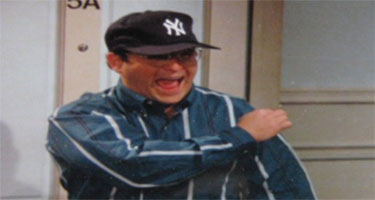
It’s hard to make fun of Vince Carter as a Net because he didn’t really do anything wrong — except not playing defense, which on a scale of horror from one to Vince Carter is a two, maybe a three. Still, there’s no question that the second phases of these storied careers was defined by pulling a 180 from the preceding parts. There was even an entire episode of Seinfeld that illustrated as much. Let’s look at the stat lines from Carter’s 20 games in 2004-2005 with the Raptors and the 57 games with the Nets:
Toronto: 15.8 PPG, 3.3 RPG, 3.0 APG, .411 FG%, .322 3P%, .694 FT%
New Jersey: 27.5 PPG, 5.9 RPG, 4.7 APG, .462 FG%, .425 3P%, .817 FT%
I can’t be positive, but something strikes me that says Vince Carter was excited to leave the Raptors and come to the Nets. New Jersey got a bizarro Carter, if you will, one who did everything the opposite of the way he did it in Canada. And George was really no different in getting his job as the Assistant to the Traveling Secretary of the Yankees:
(Let’s be honest: that’s exactly how Bruce Ratner would have reacted if Vince Carter insulted him.)
Their commitments to avoiding their instincts actually lasted for awhile, too. Vince played defense occasionally, and George used his new-found willpower to steer clear of hiring a bombshell secretary and instead hired a much less attractive, much more productive one.
So their careers were looking up, somewhat. They were happy and they were invested. But they weren’t winning — Vince in the basketball sense of the word and George in the Charlie Sheen sense. And as one might expect, the failure to win ate away at them until they fell back into their bad habits.
George gave in to his primal urges and went on to have sex with the secretary despite never anticipating he’d stoop to that level. Ignoring his tendency to chuck on the hardwood, Costanza took one for the team and said, “You know what? I don’t want to see Vince go down like I did.” So he offered some precious advice to help keep Carter from returning to his lethargic ways. First, he showed him how to get away with sleeping on the job, a skill he’s still adeptly applying today. More importantly, though, he gave him a lesson that would invariably keep the many critics off his case: if you always look annoyed, you look like you’re busy:

Sadly, though, there was a major divergence in the way that Vince left the Nets and the way that George tried to leave the Yankees. It was clear that the Nets were in rebuilding mode after they shipped away Jason Kidd and Richard Jefferson, and it was only a matter of time before Carter would be gone, too — and, really, that was probably the reason he didn’t put up a big stink: he knew it would take less effort just to ride it out rather than actively lobby for his “dismissal.”
George, on the other hand, was all too committed to getting fired from the Yankees and ultimately failed at that, too:
And you’ll have to further suspend your disbelief in the comparison at this point, as the Nets don’t even know what a championship trophy looks like, let alone have one to be desecrated.
If you could identify the high point in these two careers, the Nets/Yankees period was certainly it. But practically, that’s like calling the 2006 Nets-Suns game I recently reviewed the best of Marcus Williams’ career. It might be true, but does that fact mean anything at all?
Sidebar: Vince Carter’s Mindsets Theory
Most of you know George Costanza’s Worlds Theory: There’s Independent George and there’s Relationship George. Mix those two worlds and there will be major problems. “A George divided against himself cannot stand!”
Let me present to you, however, Vince’s alternative to the Worlds Theory, the Mindsets Theory. Here are the two personas:
- Hopeless Vince—this is the individualistic Vince who has all the raw talent to be great, scoring buckets, throwing down amazing dunks, and generally being awesome on the basketball court (except for the whole playing defense thing);
- Winning-Situation Vince—this is the Vince who is on a good team with all the talent around him to contend for a championship.
Again, the problem is that the two Vinces are not compatible. Hopeless Vince is great on teams that don’t compete, and that was the case for a large portion of his career with Toronto and New Jersey. Winning-Situation Vince was nascent for so long, though, that it wasn’t prepared for its role; Hopeless Vince had been dominant for so long that it wasn’t prepared for Winning-Situation Vince’s insurrection.
So when Carter got to the Magic, that spelled trouble. The two Vinces were in a battle for the first time, and the victim was Carter’s production. The Mindsets collided, and Vince was helpless to resist.
The Orlando Magic/Play Now Years — From Secretly Not Caring to Openly Not Caring
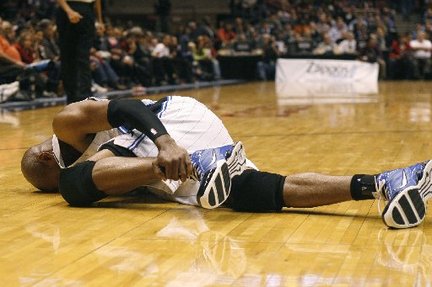
After the Nets shipped Carter to the Magic, a lot of people thought that might be the missing piece to Orlando’s championship hopes. But how could they have expected their second-best player to display less passion for basketball than anyone had before (excluding Phoenix Suns Vince, of course)? It’s a fair question. But had we been studying George, we would have known what the Magic were in for.
Moving on to Play Now, George took his self-interested apathy to a whole other level. Just to get the job, he faked an injury in his foot and really, really milked it for attention at the expense of his coworkers. Jeez, isn’t it alarming how much this sounds like Vince Carter?
Soon enough, George was found out. Mr. Tomasulo confronted George in the hopes of amicably solving the problem in what I’m nearly positive is the same as a conversation that Carter had with Otis Smith midway through last season (apologies for the poor quality):
So Carter’s sojourn didn’t really work out for the Magic, and they’d probably like to have Courtney Lee back right about now. But at least they could take some solace in the fact that Vince didn’t fill one of the team’s rubber balls with oil and drop it out a window onto an unsuspecting woman who hates jovial, booming voices, right?
You guessed it — that’s how George’s run at Play Now ended. But at least he managed to get in to his office to the dismay of Mr. Tomasulo in a typical display of fruitless commitment.
The Phoenix Suns/Kruger Industrial Smoothing Years — Really? Still?
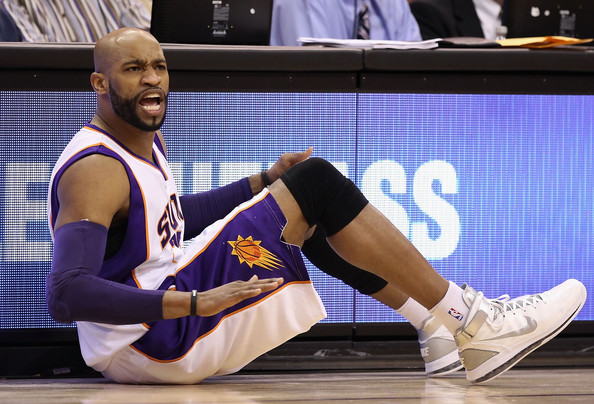
You may have heard of limping to the finish line. You’re way off. This is more like having your opponent carry you over the finish line because he feels so bad for you. Not only is the notion that Vince Carter gets paid tens of millions of dollars is a season hilarious, it’s also true. What’s even funnier is the fact that I had to clarify that.
But these stops on the Carter/Costanza express, while depressing, were also quite laughable. For Carter, he has issued a challenge to himself to see how many games he can rack up without playing during crunch time. It’s tougher for him now, though, because he can’t fake injuries, what with the Suns’ miraculous training staff there. No one would believe him!
For George, Kruger was the first person he ever encountered that cared less than he did about his job. “We don’t care, and it shows,” as George described the company. Needless to say, this goes a long way in describing Suns’ management, too. Not only did Robert Sarver force Steve Kerr out and let Amare Stoudemire walk, he also traded for Vince Carter.
But as their careers have winded down, at least they’ve gotten in to the giving spirit. George jumped at the chance to distribute cards informing coworkers of a nonexistent donation in their name to the Human Fund, to which Kruger unknowingly pledged thousands of dollars in addition. Doesn’t this sound like the Josh Childress investment? You’re attracted to an asset merely because someone tells you it’s a good thing, and then you throw way too much money at it and it ends up being a total failure?
As for Vince, he’s perfectly happy giving Steve Nash assists on the uncontested layups he makes these days. More importantly, though, he gives Grant Hill the gift of not being the player on the team with the greatest collapse from the peak of his career. It’s not about winning, really. Giving back is all that matters.
At this point, I think this scene would rather accurately depict a run-in between Vince and George:
With all that said, I can very confidently say that Vince Carter’s career will not end with him sitting in a jail cell discussing the nature of a second button on a dress shirt. Then again, I’ve been wrong before.
Seinfeld has been gone for awhile now, though it remains in syndication. While George might be gone now, here’s a little lesson for you.
George’s “death” takes place in the shadow of new Vince Carter. He’s not really dead if we find a way to remember him. And that’s the beauty of Vince — as long as he clings to some scraps of his NBA career, we’ll always find a way to remember George. But it remains a question if being associated with George Costanza is a good thing.
George’s real-estate boss, Levitan, had an interesting take on it: “You can’t win. You can’t beat me. That’s why I’m here and you’re there. Because I’m a winner. I’ll always be a winner, and you’ll always be a loser.”
It makes you wonder, when Toronto GM Rob Babcock met with Carter before he shipped him to New Jersey, how likely was it that line came up?












